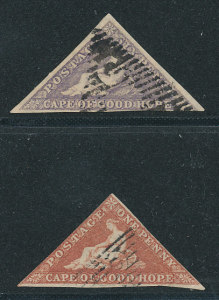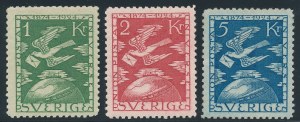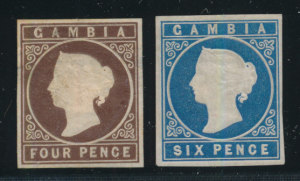Monthly Archives: October 2014
- Posted October 31, 2014Read more »Foreign collectors believe that collecting United States stamps is the most difficult of all national collecting specialties. The reason is that we make too many major catalog numbers of stamps on which the differences are very hard to distinguish. It starts with the one cent 1851's of which there are seven major catalog numbers of a single design and color, but it really reaches its apotheosis with the Bank Note Issue beginning in 1870 (These issues are called the Bank Note issues because the the US Post Office changed its printing contract to award it to a printing company that also printed currency).There are three main issues of Bank Notes along with numerous reissues and special printings and in all comprise nearly 60 major catalog numbers for eleven different stamp designs. The catalog does a pretty good job with an overview of the very subtle differences that distinguish
- Posted October 29, 2014Read more »

The two most Southern British areas of influence-Australia and South Africa- were also the latest to confederate and begin issuing postage stamps as a single geographic unit. South Africa confederated in 1910 and before that was made up of the Boer dominated Transvaal, Orange Free State, and Stellaland and British dominated Cape of Good Hope. In 1855, Cape of Good Hope became the first stamp issuing country to issue stamps that were not rectangular endearing itself to the first generation of collectors. The Cape was a thriving trading colony and postal communication was well used by the inhabitants. The triangular stamps of the Cape were always popular and sought after from the very earliest days of philately. But popularity in stamps not only requires that collectors want an item, it requires that there be enough of an item in philatelic hands that active trading can take place and collectors can afford to obtain them. In the 1890's a merchant ship arrived in London and - Posted October 27, 2014Read more »Philatelic history suffers from the fact that stamp collecting is not an academic discipline. Academic history is a constant process of evaluation and reevaluation of sources, previous historic writing and conventional understandings. Several of the latest award winning histories of the early American Colonial period that I have read present quite a different spin on the period compared to how this era was understood when I studied it in college. Academic historians make their reputation by finding new sources and reexamining the old in a way that never exists with those who look at the philatelic past.Stamp histories are largely anecdotal-memories and stories about the great collectors and dealers. I say this because of an important piece of information on philatelic history that I came across recently. I have been reading the first years' journals of the London
- Posted October 24, 2014Read more »
Until 1970 the stamp market in the United States was mostly determined by the domestic market alone. Virtually all stamps, both US and Foreign, that were sold in this country were sold to domestic buyers. International travel was unusual and expensive, there was no Internet, and American philatelic auctioneers didn't send many catalogs overseas. 1970 was a watershed year as it marked the period that the economic balance began to shift between Europe and the United States. Until 1970, Europe was still economically weak and recovering from the devastation of WW II. After 1970, the dollar was devalued several times against the mark and other European currencies, which pushed up prices of these stamps in dollar terms. And the rapidly expanding European economies gave consumers there more money to pursue their hobbies also putting upward pressure on prices. Large numbers of European dealers flocked to our shores and millions of dollars of European stamps flowed back to their countries
- Posted October 22, 2014Worldwide postal services have tried numerous experiments over the years at increasing revenues. Most common has been the experiment of advertising with postage stamps. This experiment was first made almost coincidentally with the issuance of the first postage stamp. The Mulready envelope was issued together with the Penny Black as the world's first piece of postal stationery and private companies quickly began advertising on part of the writing page of the stationery. These letter sheets were then sold at discounts from the postage value to people willing to have such advertising with their mail. In the late nineteenth century, New Zealand experimented with placing printed ads on the backs of postage stamps. As these ads could only influence the buyers of the stamps and only then until the stamps were glued to the envelope, they enjoyed limited success and never had government sanctioned use elsewhere. The greatest success for postal advertising has been as se tenantsRead more »
- Posted October 20, 2014Read more »

By 1874 the system of international carriage of letters was a mess. Countries had to negotiate postal treaties with each other and most treaties called for cross payments where part of the postage of a letter was remitted by the sending post office to the receiving post office. This was confusing and difficult to keep tabs of but of further complexity was the cross payments to transit countries (say when a letter from the United States landed in England, was sent to Poland and then across land to Russia). Nearly thirty five years after the Penny Black, with world commerce rising, the system of cross payments just wasn't working. It was slowing down communication and as postage rates dropped it was becoming more expensive to account for the letters than to carry them. In 1874 the United States proposed an international congress to discuss the problem and what emerged was an agreement for an organization that was one of the first international cooperation organizations (it - Posted October 17, 2014Read more »Before 1859 Romania didn't exist in its current form and one of its component nations, Moldavia, was one of the first issuers of stamps. The famous Moldavia Bulls have been a favorite of philatelists since the beginning of our hobby. They combine the three characteristics that collectors most esteem-they were issued for purely postal purposes with no advance warning to collectors and no hoarding. They are primitive in design and execution. And they are, and always have been, rare. A short look at these three philatelic characteristics of popularity will help explain how our hobby developed and cast light on many aspects of philately that are still with us today.The relationship between stamps' postal purpose and philatelic issues has always been a confused one in the mind of many stamp collectors. The earliest stamps were obviously always completely non philatelic in origin but by about
- Posted October 15, 2014Read more »Most stamp collectors are married men. In fact, if you had to pick the person who was at the exact center of the philatelic demographic in this country you would have a married man in his sixties with grown children. He would be more or less happily married. He and his wife share nearly everything together. They have children, and if they are lucky, grandchildren who they enjoy together. And they share and enjoy together friends, movies, even books. But the one thing our demographically perfect collector and his wife do not enjoy together is his stamps. Very few couples contain two stamp collectors. And when they do they always collect different areas, never together.Collecting is at its heart a solitary pursuit. Many collectors belong to societies but most do so in order to use some society services such as a magazine, or sales circuits and not for social philatelic
- Posted October 13, 2014Second chances sometimes work out in life, but they almost never do in philately. The 1930 Zeppelin stamps were issued in 1930 and their high face value during the Great Depression meant that many collectors had to forgo buying them and that many people who bought them could only afford one set and not put any away for future sale. Prices of the 1930 set rose quickly after they were withdrawn from sale in 1931. So when the United States Post Office announced in 1933 that they were giving collectors another chance to buy a stamp that seemed certain to go up in value (and at a significantly lower face value than the first set) collectors lined up for the largess. So much so that the Baby Zeppelin ( Scott # C 18) has been a bit of drug on the market for the last eighty years. The stamp moved up in price steadily from its 50c face value to a few dollars each in the early 1960s. It enjoyed a significant run in the late 1970s, when all stamps wentRead more »
- Posted October 10, 2014Read more »

Chile was one of the last South American countries to be colonized. With little gold or silver to exploit or passive Indians to enslave, the southwest coast of South America was not as attractive to the Spanish invaders as was the rest of the new world. Colonization came later when copper was found, and when the rich Mediterranean style climate showed that European type crops (and especially grapes) could be grown and when steam sailing ships and railroads could link the long narrow nation. Geographically, Chile is a narrow ribbon of a nation averaging 100 miles wide by 2700 mile long. The first stamps of Chile were issued in 1853 and were produced in London. The plates were transferred to Chile and over the next fifteen years numerous printings were made. With "a" numbers, Scott recognizes about sixty different printing, shade, watermark and color varieties putting the first issues of Chile in the same class as the classic Hermes Heads of Greece as among the most super specialized - Posted October 08, 2014Read more »
The stamp dealers of the older generation had a fair number of odd characters but none were odder than Morton Paul Goldfarb. Mort, as everyone called him, went to every auction, every stamp show and no matter where you went, you were sure to see him too. Mort specialized in the stamps of the United Nations and only UN. There aren't many better UN stamps in which to deal and Mort made a specialty out of buying and selling UN postage. The United Nations postal agency is really not a post office at all. UN stamps are souvenirs and the UN maintains a Post Office as kind of a postal fiction. All letters deposited at the UN Post Office are turned over to the United States Post Office which is required by Congress to handle UN deposited mail. It is another US subsidy of the UN. The USPS provides the service and the UN gets the revenue for the sale of the postage.
But to make the burden on the United State Post Office less, the UN has always restricted how their - Posted October 06, 2014Read more »The fear of the counterfeiting of postage stamps made for a large number of Nineteenth Century printers' trade offs. The gold standard of anti-counterfeiting technology was line engraved (called intaglio) printing, which, for a special anti-forgery bonus, usually included lathe work. This type of printing rose off the paper and produced a fineness of design that didn't make counterfeiting impossible but made it more difficult and raised the cost (both in time and expertise) to the forgers considerably. Producing line engraved stamps is similar to putting a burglar alarm sign on your front lawn or using the Club in your car. Raising the cost and risk to forgers or thieves means they look elsewhere to earn their living.Gambia didn't want to pay the cost for line engraved plates for the small press runs of their first issues. The main cost of line engraved is the hand engraved
- Posted October 03, 2014Read more »Until about 1950, philatelists were quite content hinging their stamps. The first stamp mounts in the United Stateswere Crystal Mounts, marketed by the H E Harris Company. They were not created because collectors wanted (or could be convinced they wanted, which is they same thing) a better way to mount their stamps. Rather Crystal Mounts were really a pain to use and were marketed solely to add a non-stamp item to the Harris line. Harris found he made more money from albums and mounts than he could from stamps. Crystal Mounts were clear acetate strips that collectors wrapped around their stamps and then cut the mounts to the desired size. Stamp mounts have always had two problems- the problem of height and the problem of horizontal and vertical.
- Posted October 01, 2014







